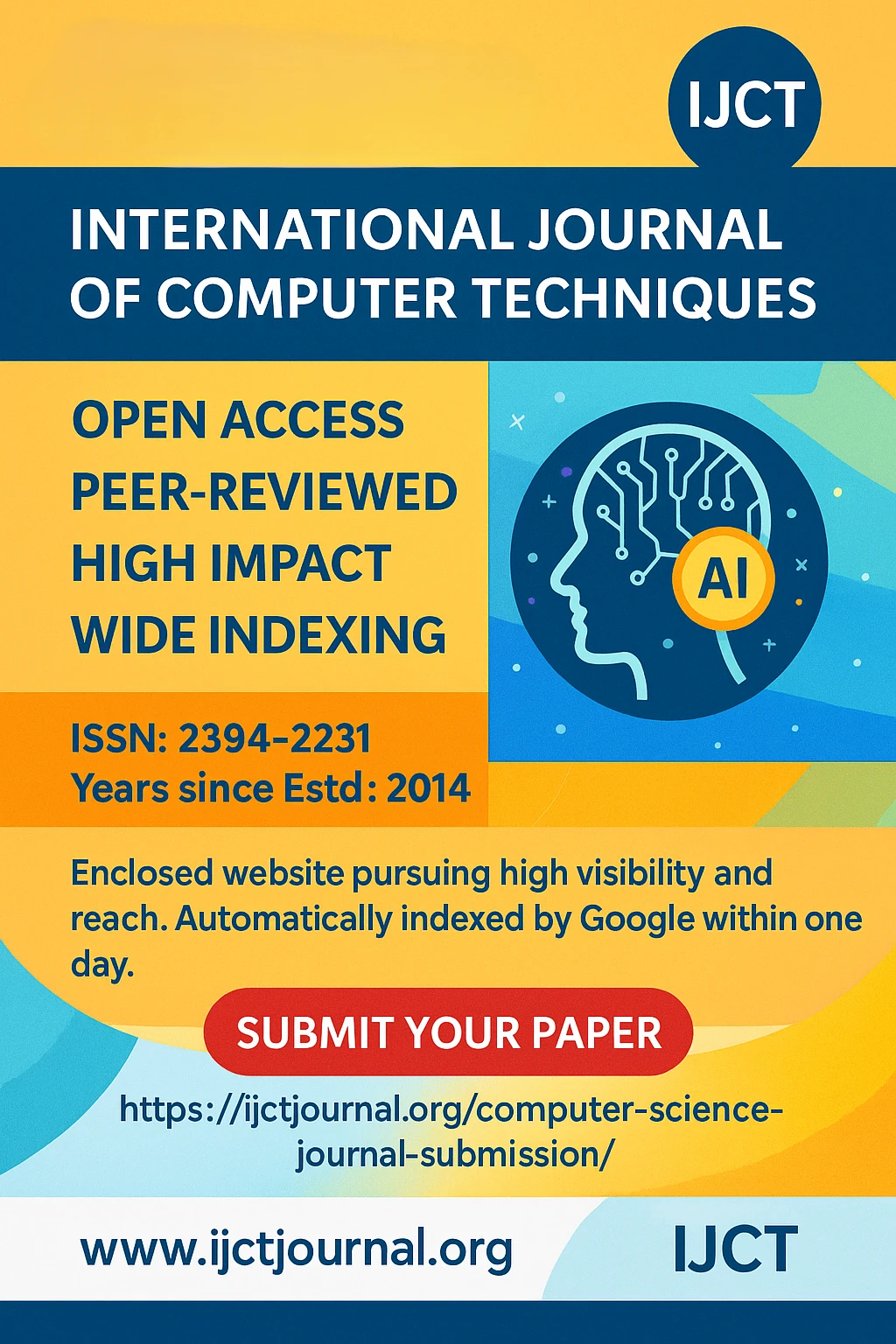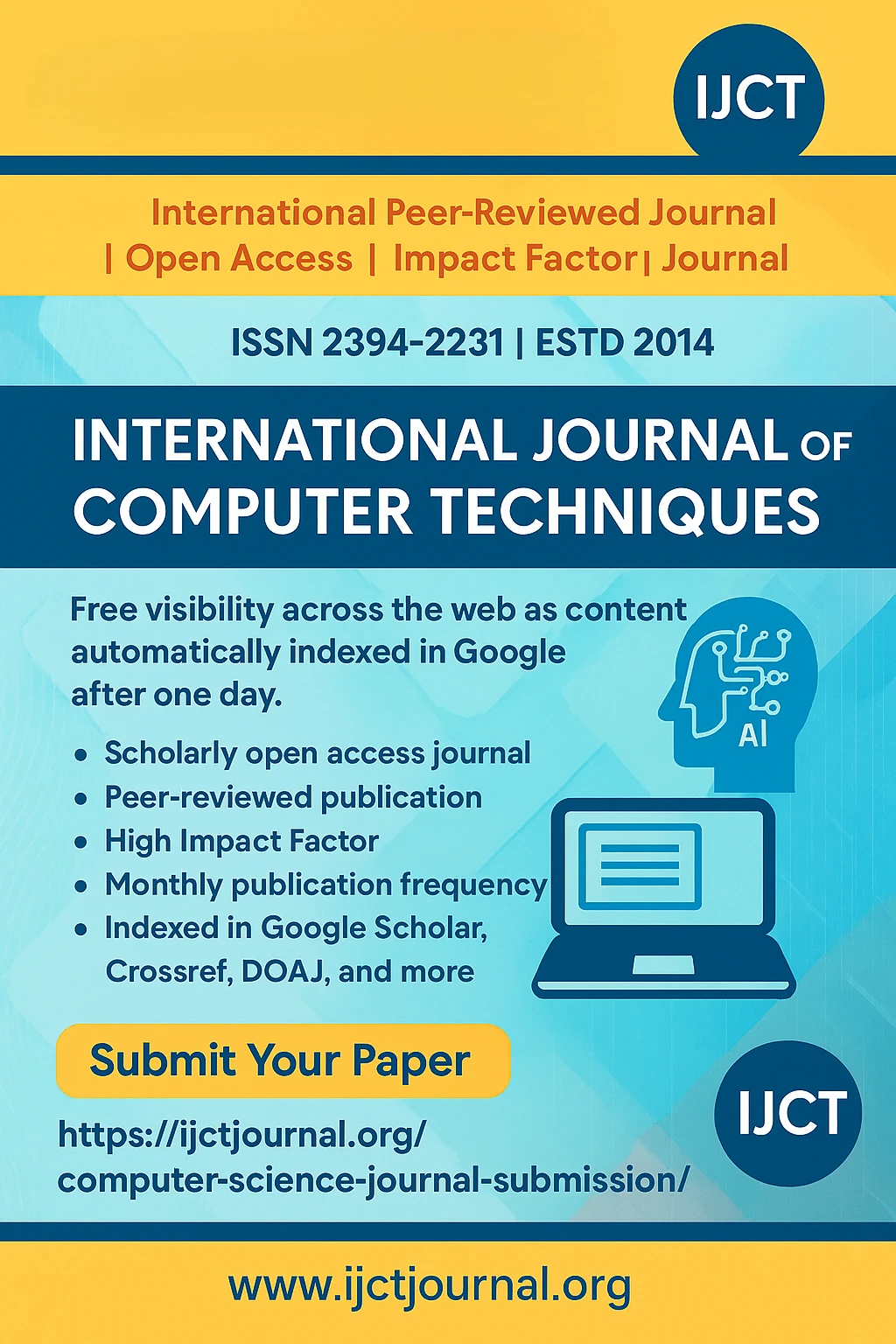
Hybrid Feature Selection and Classification Approach for Intrusion Detection in Wireless Sensor Networks Using LEACH Routing Protocol | IJCT Volume 12 – Issue 5 | IJCT-V12I5P61

International Journal of Computer Techniques
ISSN 2394-2231
Volume 12, Issue 5 | Published: September – October 2025
Author
Satish Dekka, Dr. Prasadu Peddi,
Dr. Manendra Sai Dasari
Table of Contents
ToggleAbstract
Wireless Sensor Networks (WSNs) are increasingly deployed in diverse and resource-constrained environments, making them prime targets for a variety of security threats, including the infiltration of malicious nodes. This article proposes a novel hybrid framework that integrates advanced feature selection techniques and robust classification algorithms to enhance intrusion detection capabilities in WSNs. Leveraging the LEACH (Low-Energy Adaptive Clustering Hierarchy) routing protocol, our approach efficiently organizes sensor nodes into clusters, optimizing energy consumption while enabling effective monitoring of network activities. The hybrid feature selection mechanism systematically identifies the most relevant attributes from network traffic, reducing dimensionality and improving the accuracy of the intrusion detection system (IDS). Subsequently, state-of-the-art classification models are deployed to analyse the selected features, enabling precise detection and classification of malicious behaviours within the network. Experimental results demonstrate that the proposed system significantly outperforms conventional IDS solutions in terms of detection rate, false positive rate, and energy efficiency. The integration of LEACH protocol with hybrid IDS not only strengthens security but also prolongs the operational lifetime of WSN deployments, making it a viable solution for secure and resilient wireless sensing applications.
Keywords
Wireless Sensor Networks (WSN), Intrusion Detection System (IDS), Feature Selection, Classification, LEACH Routing Protocol, Malicious Nodes, Network Security, Energy Efficiency, Clustering, Hybrid ApproachConclusion
This work introduced a hybrid feature selection and classification IDS integrated with the LEACH protocol, significantly improving detection accuracy and extending the lifetime of WSNs. The system combines advanced data selection, adaptive machine learning, and energy-efficient clustering, overcoming key challenges in WSN security. Experiments across various network sizes showed the proposed approach consistently outperformed standard IDSs like SVM and RF, achieving higher detection rates, fewer false positives, and better energy balance. The framework is practical for deployment in real-world IoT, smart environments, and critical infrastructure. Future directions include adding real-time learning, integrating trust and secure routing protocols, validating on hardware testbeds, and adapting to new attack types further advancing secure and resilient WSN operation.
References
[1]W. B. Heintzelman et al., “An application-specific protocol architecture for wireless microsensor networks,” IEEE Trans. Wireless Commun., vol. 1, no. 4, pp. 660–670, 2002.
[2]R. Roman et al., “Applying intrusion detection systems to wireless sensor networks,” in Consumer Commun. Netw. Conf., 2006, pp. 640–644.
[3]Y. Zhang et al., “Outlier detection techniques for wireless sensor networks,” IEEE Commun. Surveys Tuts., vol. 12, no. 2, pp. 159–170, 2017.
[4]D. Singh et al., “A novel deep learning-based IDS in clustered WSNs,” Measurement, vol. 187, 110278, 2023.
[5]J. Li et al., “Hybrid feature selection and random forest for network anomaly detection,” Sensors, vol. 22, no. 4, 1508, 2022.
[6]A.-S. K. Pathan et al., “Security in wireless sensor networks,” Int. J. Compute. Theory Eng., vol. 1, no. 5, pp. 365–371, 2018.
[7]Y. Yadav et al., “An intelligent IDS for WSN using SVM,” Int. J. Info. Mgmt., vol. 52, 2020.
[8]S. K. Jaiswal and H. S. Gour, “Review of clustering-based routing in WSNs,” Wireless Networks, vol. 27, 2021.
[9]N. Mistry et al., “Advances in secure data aggregation in WSNs: A survey,” J. Netw. Comput. Appl., vol. 41, 2016.
[10]B. Sun et al., “Intrusion detection techniques in WSNs,” IEEE Wireless Commun., vol. 15, no. 5, pp. 56–63, 2008.
[11]X. Wang et al., “A survey on intrusion detection in WSNs,” Wireless Commun. and Mobile Comput., 2018.
[12]M. Jyothi, N. Kumaravel, “Analysis of algorithms for intrusion detection in WSNs,” Procedia Comput. Sci., vol. 133, 2018.
[13]S. Krishnan et al., “Routing attacks and defenses in WSNs,” IEEE Commun. Surveys Tuts., vol. 18, 2016.
[14]A. V. Senthil Kumar, “Feature selection in IDS: An overview,” J. King Saud Univ., vol. 34, 2022.
[15]A. R. Jyothi, R. V. Prasad, “Secure routing in WSNs,” Comput. Networks, vol. 151, 2019.
[16]S. Kazemian et al., “Improved LEACH for IDS in WSNs,” Int. J. Comput. Appl., vol. 180, 2018.
[17]S. K. Shaw, N. Sahoo, “Ensemble learning and feature selection for WSN IDS,” IEEE Access, vol. 10, 2022.
[18]Z. Abbasi et al., “Optimal cluster head selection in LEACH WSNs,” IEEE IoT J., vol. 9, no. 1, 2022.
Journal Covers
IJCT Important Links
© 2025 International Journal of Computer Techniques (IJCT).
Hybrid Feature Selection and Classification Approach for Intrusion Detection in Wireless Sensor Networks Using LEACH Routing ProtocolDownload
Related Posts:










